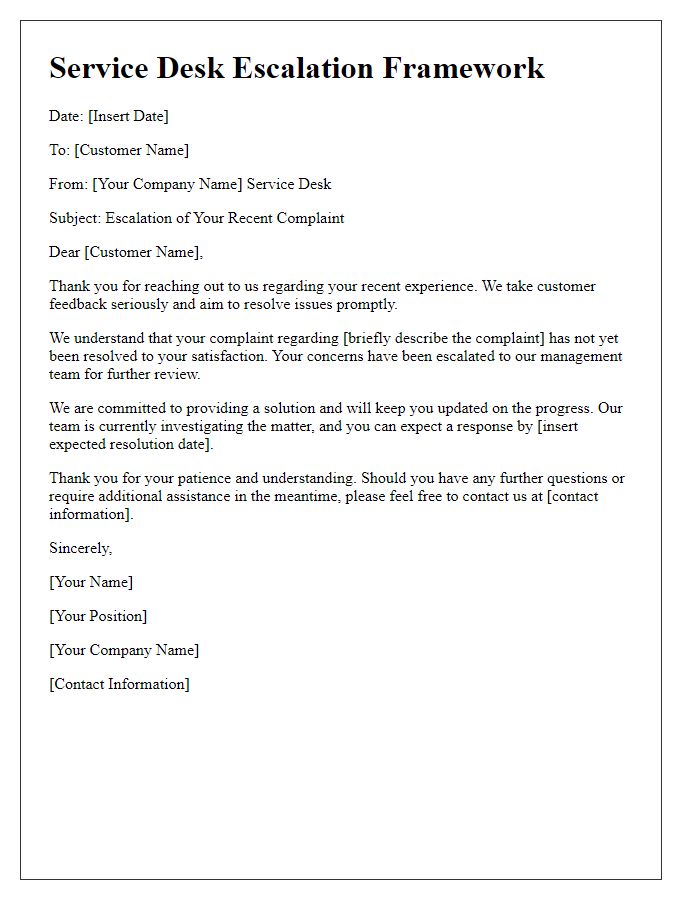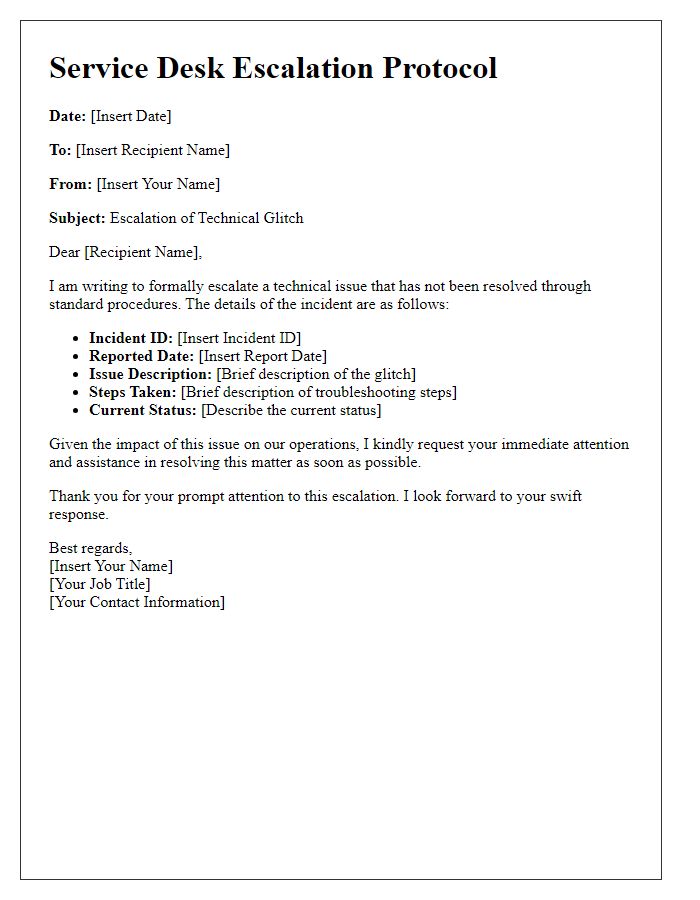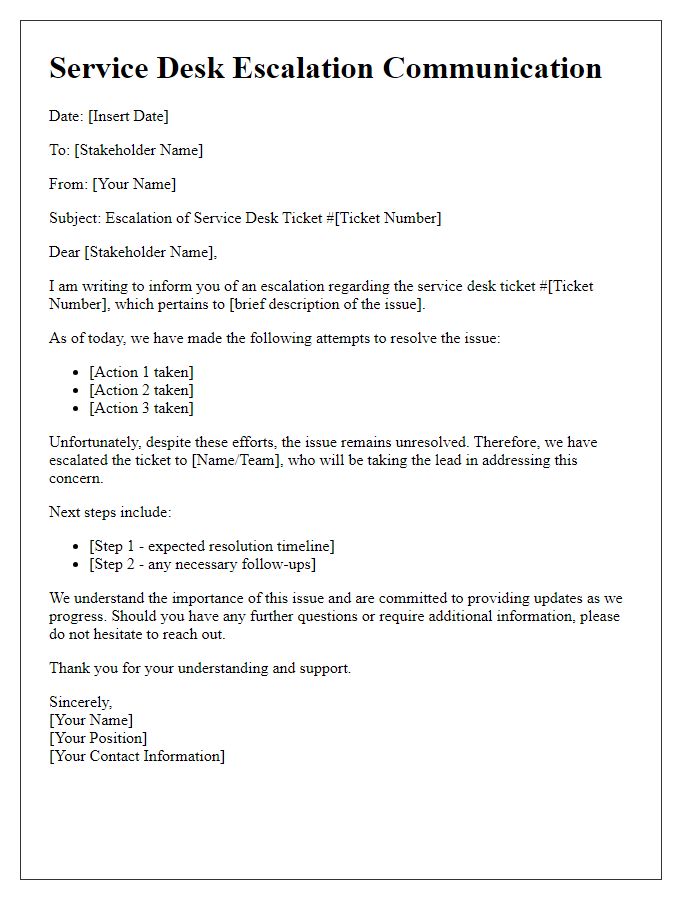Welcome to our guide on service desk escalation policies, where we'll simplify the ins and outs of ensuring your IT support runs smoothly. Whether you're a seasoned professional or just starting out, understanding these policies is vital to enhancing your team's efficiency and customer satisfaction. We break down essential elements such as when to escalate an issue and the best practices for doing so. Curious to learn more about optimizing your service desk processes? Let's dive in!

Clear escalation matrix
An effective service desk escalation policy is crucial for maintaining service quality and efficiency in resolving customer issues. The escalation matrix defines the clear hierarchical structure, specifying the responsibilities of each level of support staff. First level support, known as Tier 1, typically handles basic customer inquiries and straightforward problem resolution, addressing approximately 70% of tickets. If unresolved, cases are escalated to Tier 2, involving more experienced agents who specialize in complex technical issues, which account for about 20% of requests. For critical incidents requiring advanced skills, escalation to Tier 3 is necessary, which comprises subject matter experts or specialists. Furthermore, defined timelines for responses at each tier, such as 30 minutes for Tier 1 and 2 hours for Tier 2, enhance accountability. Regular training sessions and reviews ensure that staff members stay updated on emerging technologies, improving the overall efficiency of the escalation process and customer satisfaction.
Defined response times
Service desk escalation policies establish defined response times to ensure timely resolution of issues. These policies typically categorize incidents into levels, such as Critical, Major, and Minor, with respective response times benchmarked against industry standards. For instance, a Critical incident, affecting over 500 users, may have a response time of less than 1 hour, while a Major incident, impacting 50-500 users, is usually addressed within 4 hours. Minor incidents, affecting fewer than 50 users, typically receive a response within 24 hours. In many organizations, adherence to these defined response times is monitored through Service Level Agreements (SLAs), ensuring accountability and prompt action. Furthermore, escalation procedures are triggered if response times are not met, promoting urgency in addressing high-priority incidents.
Contact information hierarchy
In a typical service desk escalation policy, the contact information hierarchy is critical for efficient issue resolution. First-level support teams, like help desk agents, are responsible for addressing basic user issues and inquiries, particularly those related to software applications such as Microsoft Office and operating systems like Windows 10. When unresolved, these cases escalate to second-level support, consisting of specialized technicians with expertise in complex technologies like Cisco networking hardware or VMware virtualization platforms. Specific contact details, including email addresses and direct phone numbers, facilitate swift communication. Should these escalations require higher intervention, they reach the third level, involving senior IT managers or domain experts, ensuring adherence to service level agreements (SLAs) within defined response times, typically aiming for resolution within 48 hours. Effective tracking through ticketing systems like ServiceNow aids in monitoring escalation progress.
Detailed issue categorization
Efficient issue categorization is essential for effective service desk escalation policies. Categorizing issues into distinct types such as hardware failure, software bugs, network problems, or user errors helps streamline the response process. Organizations utilize tiered support levels, often labeled Tier 1, Tier 2, and Tier 3; each level corresponds to increasing complexity and expertise. For instance, Tier 1 typically handles basic inquiries and password resets, while Tier 3 addresses complex integrations and advanced troubleshooting. Proper documentation of incidents, including timestamps, user information, and detailed descriptions, is crucial for analyzing trends and improving resolution times. Additionally, employing prioritization matrices can further refine the categorization process, ensuring high-impact issues receive immediate attention while less critical matters are scheduled accordingly. Frequent training on categorization methodologies helps maintain staff competency and enhances overall service quality.
Communication protocols
Effective communication protocols are critical in service desk escalation policies to ensure smooth resolution of technical issues. Standard Response Times dictate that first-level support must acknowledge tickets within 24 hours, while escalations to second-level support should occur within four hours if unresolved. Clear Guidelines outline the criteria for escalation, including unresolved issues, customer dissatisfaction, or ticket complexity beyond the first-level team's capacity. Designated Points of Contact should be established for each escalation level, ensuring that escalated tickets are directed to the appropriate team members. Regular Updates are necessary, with status reports provided every 48 hours to maintain transparency and manage customer expectations. Additionally, Post-Escalation Reviews should occur to analyze resolution effectiveness and improve future processes, emphasizing the importance of feedback loops.
Letter Template For Service Desk Escalation Policies Samples
Letter template of service desk escalation guidelines for critical incidents

Letter template of service desk escalation process for unresolved requests

Letter template of service desk escalation framework for customer complaints

Letter template of service desk escalation protocol for technical glitches

Letter template of service desk escalation criteria for high-impact incidents

Letter template of service desk escalation communication for stakeholder updates








Comments